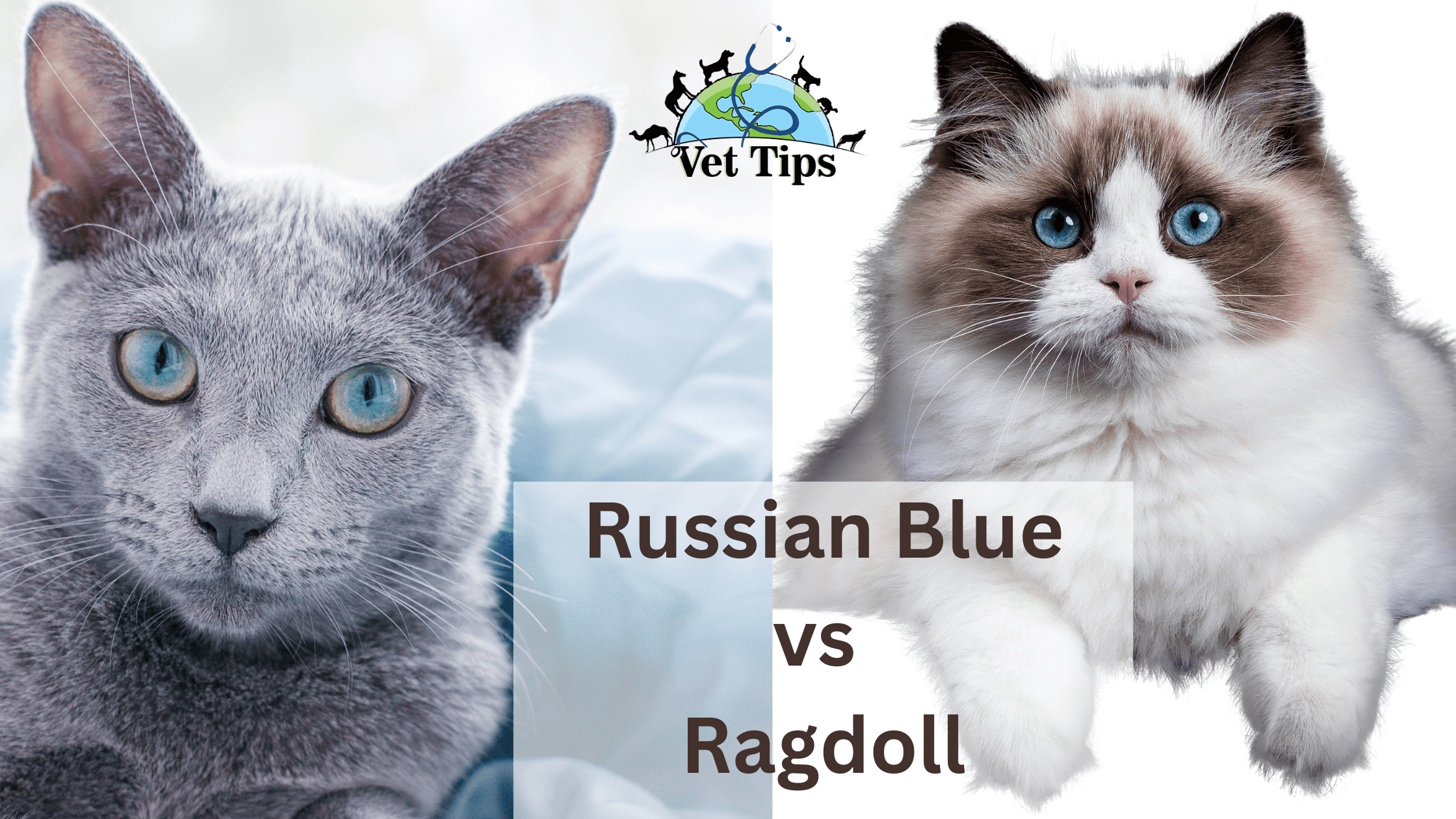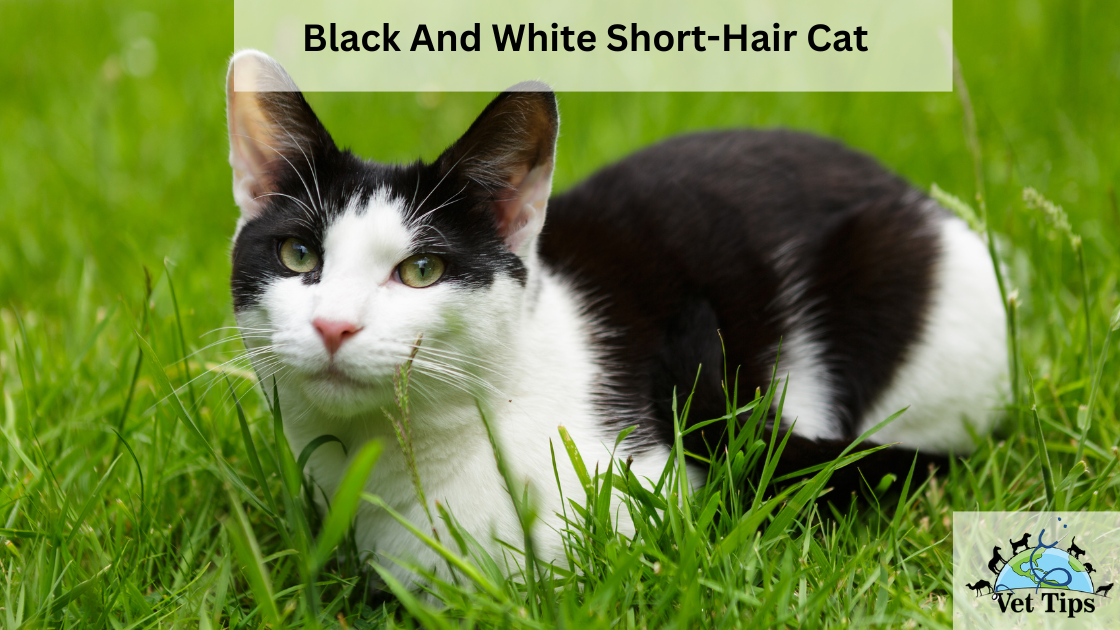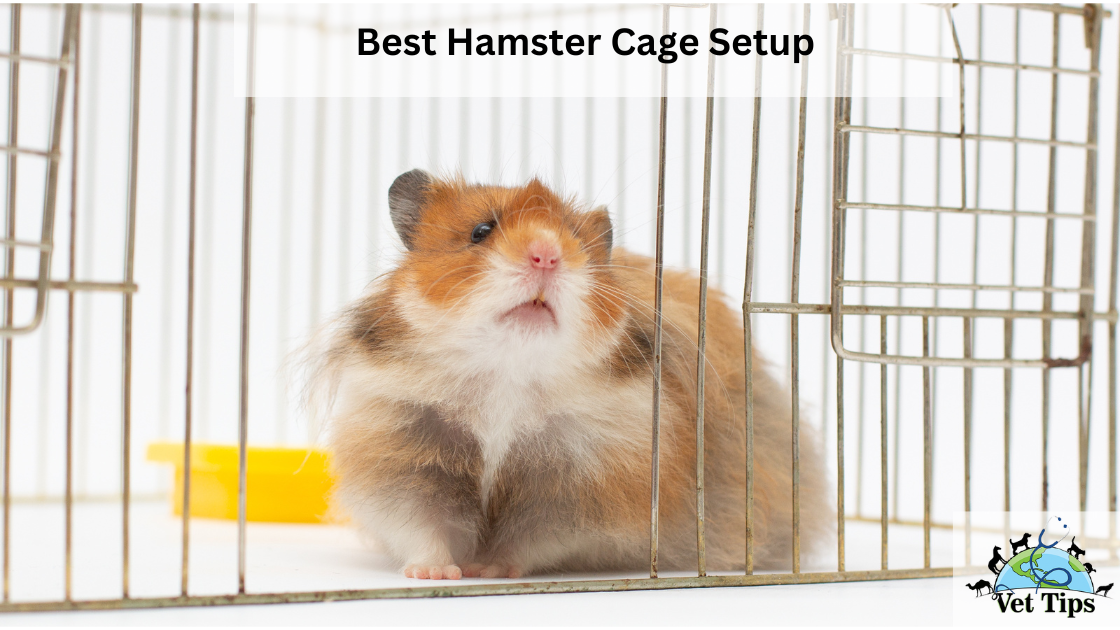In this article, we compare one of the 2 best types of cat breeds that people love: Russian Blue vs Ragdoll. Continue reading to learn more about their features and comparison.
Russian Blue vs Ragdoll General Features
Russian Blue Cat
According to the breed’s name, this cat originates in Russia and has a blue coat. Even though the color appears grey, blue is a particular term used to designate a specific color in these cats. Blue is considered to be the dilute form of black in the pet world. Although there are no exact dates for when this breed originated, it is a more ancient breed and one of the oldest acknowledged cat breeds. This breed is well-known for its enthusiasm for fetching objects. The majority of Russian blues make excellent family pets, get along well with other animals, including dogs, and are gentle with youngsters.

Ragdoll Cat
The Ragdoll cat is an excellent choice if you want a giant, friendly cat that is also willing to go with the flow. When these cats are caressed, they collapse with delight, earning them the nickname “Lippin’ Cats.” This cat breed is one of the most numerous on the market, but don’t let that deter you from getting one. Their huge blue eyes and booming, throaty purr give away the fact that these cats are total softy in every way. Because this cat is very gregarious, they are an excellent choice for homes with many activities.
Russian Blue Characteristics
The Russian blue cat is a medium-sized feline that is thin, robust, and muscular, with long legs. She can range in weight from 3 to 6 kilogrammes. She has a beautiful blue, velvety double coat that is short and thick, and it is short and thick in places. The coat is a uniform shade of grey with silver points. The fact that this cat’s double coat doesn’t shed much is also an appealing characteristic. The cat’s head is triangular, and its eyes range from yellow to green in colour.
Victor, a well-known cat enthusiast, and researcher, find the patterns of molecular genetic variation among cat breeds which aid in studying evolutionary patterns between Russian Blue and Ragdoll Cat.
Ragdoll Characteristics
The lovely Ragdoll cat is a large, heavy-boned feline with a delicate appearance. They can weigh up to 9 kilograms at times. It has a silky, velvety coat that can range in length from semi-long to long.
The cat has a stunning blue eye and a gorgeous silky coat that comes in various colors, including cream point, chocolate point, seal point, and others. The ears are medium in size, the legs are long and robust, and the blue oval-shaped eyes are on the side of the head. The cat is classified as a pointed breed because its body is lighter in color than the points on its tail.
Russian Blue vs Ragdoll Detailed Comparison
Russian Blue Temperament:
Her personality is that of a generous, sweet-tempered cat who enjoys nothing more than being in the company of her human companions. She is also calm and self-sufficient. They get along well with their human families but build a strong attachment to one individual.
She will even accompany her owner everywhere he goes, and she is a caring and faithful buddy. The Russian Blue is a gregarious cat, yet she also appreciates some alone time relaxing and doing nothing. She is also not fond of visitors, and if the gathering grows too large and raucous, she may flee and seek refuge elsewhere.
This is a cat that will miss you if you are out at work for the entire day, but she is also capable of waiting patiently for your return. After that, she’ll be grateful for some playing.
Ragdoll Cats Temperament
Ragdolls are cats who are relaxed, even-tempered, and laid-back in their demeanour. They are playful but not very energetic; therefore, you will not see these cats leaping to the top of high perches like you would see other cats do.
These docile cats enjoy being handled, pampered, and carried around in a carrier. It falls to the ground in delight at the thought of being cherished and nurtured by its human partners. This cat is quite friendly and will even welcome you at the entrance and learn to play a few games, much like a dog. She is also knowledgeable.
With children and some other pets in the house, this friendly cat is an excellent family pet, and she can even be taught to walk on a leash with a bit of help.
Russian Blue Cat’s History
Despite the fact that the original origins of the Russian blue are unknown, these cats were formerly known as Archangel cats since they were brought ashore by ships from Russia’s Archangel Island or Arkhangelsk, respectively. This cat was a favourite of royalty, and it was also a favourite of the Russian czars.
These cats were transported to various locations throughout Europe. Russian blues were among the cats that competed in the first cat shows organised in England in the 1880s, and they were also among the winners. The Cat Fanciers’ Association of America and the International Cat Association in the United States of America are recognised by the Russian blue cat.
Here you can find the ascent of cat breeds: genetic evaluations of species and worldwide random-bred populations presented by world-known cat vets and scientists
Ragdoll Cat’s History
When compared to many other breeds, this cat is a relative newcomer. California was the birthplace of the Ragdoll cat breed, which originated in the 1960s. Ann Baker, a cat breeder from the United Kingdom, wants to raise a gorgeous cat with a caring nature. Ann began to use domestic medium-haired cats of unknown origin while she was in her twenties. Josephine, the first mother cat of the breed, was a pure white cat named Josephine.
Although it took several generations, Baker eventually produced the first cats that came to be known as Ragdoodles. Aside from their non-matting coats, their vast size and gregarious personalities made these cats a popular choice for adoption.
Unfortunately, in the 1970s, there was a rift between Baker and a group of other Ragdoll enthusiasts that resulted in a lawsuit. In the end, many of the early Ragdoll breed enthusiasts, including Baker herself, came to a mutually agreeable conclusion. Despite all of this upheaval, the Ragdoll breed continues to be popular today.
Ragdoll cats were first registered by the Cat Fanciers Association (CFA) in 1993. Ragdolls are the fifth most common cat breed registered with the Cat Fanciers Association (CFA).
Care of a Russian Blue Cat
The Russian blue’s hallmark coat is a shimmering blue with a silvery tinge that is distinctive to the species. The Russian blue cat’s short, dense, silky coat is incredibly easy to care for, requiring only the essential grooming techniques. Its coat sheds very little as a result of its innate characteristics. Brushing the coat regularly will keep it soft and silky.
Perhaps even more remarkable than the Russian blue’s coat are vast, almost spherical, wide-set, emerald-green eyes set wide apart. The Russian blue’s head and face are shaped so that it appears to be continually smiling, lending it a delightful smile.
Clean and trim your Russian blue’s nails regularly, and inspect the inside of his ears for dirt and debris once a week. You can clean out the ears with a cotton ball if you notice some debris inside them after using a gentle pet ear cleaner (never a cotton swab). If your Russian blue’s ears appear inflamed or overly unclean, or if your Russian blue is tossing its head or scratching its ears, arrange an appointment with your veterinarian right once.
Continue…
The Russian blue cat is a medium-sized cat with fine-boned, elegant, and slender features, but it is highly muscular. Make sure your cat has access to a scratching post so that it can get some much-needed stretching. This breed can keep itself engaged and exercising independently, which is ideal for families who lead active lifestyles. Cat food quantities can be controlled to maintain a healthy weight. If your cat becomes overweight, lower the amount of food supplied to her and consult with your veterinarian.
It is believed that Russian blues are intelligent cats. They are lively and playful cats, and they may be taught to fetch if they are given the opportunity. Even though they are not a talkative breed, they will generally answer when spoken to and encouraged to speak. These beautiful cats are soft and charming in their disposition. When it comes to outsiders, the Russian Blue can be apprehensive, yet they are entirely devoted to their owners. A dog-like cat that will welcome you at the door, follow you around the home, and sit next to you on the couch is what you’re searching for. The Russian blue cat satisfies all of these requirements.
Care of a Ragdoll Cat
There is no underlayer of fur on the Ragdoll’s silky single coat, which means it does not have an undercoat of fur. It is designed to mat less than other medium-haired cat coats, according to the manufacturer. This breed still requires brushing at least twice a week to avoid matting and other problems.
Ragdolls also require regular cleaning of their ears. Fill the cat’s ears with a warm feline ear cleanser and gently massage the outside of the ear to clean it. Make sure you have some meat-flavoured baby food or other extra-tasty cat treats on hand to keep your feline companion quiet during this procedure. After around five minutes, clean the inside of your cat’s ears with a cotton ball to remove any debris.
Ragdolls require toenail trimming regularly, just like any other cat. After receiving a pedicure, keep in mind that your cat will most likely want to sharpen her claws even more than usual, so make sure to offer her some excellent scratching posts!
Ragdolls are also highly lively and gregarious cats. They require constant interaction with wand toys or other interactive cat toys to keep them entertained. Most cats also benefit from being fed out of a feline puzzle feeder, which can be found here. Get up and play with your cat instead of just leaving toys around for her! Keeping your cat’s weight under control, avoiding behaviour problems induced by boredom, and strengthening family ties are all benefits of doing so.
Is it true that Russian Blue Cats are Hypoallergenic?
The Russian blue cat breed is frequently included in listings of cat breeds that are considered “hypoallergenic.” It appears that some allergy patients can live happily with some cat breeds, such as the Russian blue, despite the fact that there are no cat species that is non-allergenic.
Cat dander (not necessarily cat hair) is the most common cause of cat allergies, rather than cat hair itself. Fel D1, a protein found in cats’ skin cells (and dried saliva and urine on their fur), causes allergic reactions in humans allergic to cats. Cat-allergic humans are sensitive to this protein. Although it has not been scientifically verified, some cat breeds, such as Russian blues, naturally create less dander than other cats, contrary to popular belief. According to the manufacturer, people who have slight allergies may live happily with a Russian blue. Individual cats and people, on the other hand, are all distinct.
You should find a local breeder who is willing to let you visit their house or breeding facility if you have cat allergies and are interested in learning if a Russian blue will cause an allergic reaction. Get some hands-on experience with a couple of Russian blue adult cats to put the theory to the test.
Is it true that Ragdoll cats are Hypoallergenic?
Ragdolls are not hypoallergenic, which is a disappointment for allergy sufferers. Although some allergy sufferers report that medium-coat cats are less bothersome, Ragdolls are not specifically developed to be hypoallergenic. Breeders who make claims about their Ragdolls being hypoallergenic are attempting to make a quick profit!
Ragdolls do not have an undercoat, which means they are less likely to cause allergic responses in persons who are sensitive to animal dander. However, the majority of humans are allergic to the saliva and skin secretions produced by cats. Ragdolls continue to produce the allergens found in cat saliva and skin secretions, which are harmful to humans.
Russian Blue Cat’s Diet and Nutrition
Whenever possible, it is recommended that you consult with your veterinarian on the finest food to provide your Russian blue. Because the Russian blue is known to be a voracious eater, one thing to keep an eye out for is overfeeding. Maintaining a healthy weight for your Russian blue is the most effective approach to avoid weight-related health problems, including diabetes, heart disease, and arthritis. Ensure that you feed your Russian blue cats measured portions of cat food at regular meal times, two to three times per day. However, while putting food out all day may be handy, it might lead to constant munching, resulting in an overweight cat. Make sure that fresh water is constantly available, 24 hours a day.
Ragdoll Cat Diet and Nutrition
With the help of your veterinarian, come up with a diet that’s appropriate for your Ragdoll’s age and level of exercise. Wet foods, in general, help to give the moisture that can aid in avoiding urinary difficulties from occurring. Ensure to portion out the food and not keep it out in your cat’s bowl all day long. The practice of leaving food out has been linked to diabetes in cats, maybe because insulin levels rise every time a cat consumes food, regardless of how high-quality the food is. Because cats use up most of their time lying around, using puzzle toys for feeding is an excellent method to make your cat’s life more fascinating.
Here you can read the risk factors of high calcium oxalate diet in Ragdoll cats presented by Chalermpol Lekcharoensuk (A renowned pet veterinarian)
Grooming of the Russian Blue
The Russian Blue’s lovely blue coat is short and thick, and it will benefit from a once-weekly brushing to maintain its appearance. During brushing time, the cat adores being the centre of attention.
- Maintain the health of your Russian blue nails regularly.
- Provide your cat with what she requires to live a happy and healthy life. A litter box, a collar and tag, a beautiful soft bed, grooming supplies, a climbing tree, and a scratching post are all required.
- Ascertain that she has received his cat vaccinations and has been treated for parasites.
Grooming of a Ragdoll
However, although Ragdoll’s coat is long and silky, it is the type of coat that does not require much attention. In any case, comb and brush it once or twice a week would suffice.
- She also requires frequent nail clipping as part of her grooming regimen.
- Understand what your Ragdoll eats and when they consume it. Remember that cats are carnivores, which means that the majority of their diet must consist of meat. These cats enjoy food puzzles, but whatever snacks and treats you offer your Ragdoll, be sure they are nutritious for cats and will not cause your cat any stomach issues.
- Make sure to provide your Ragdoll with a litter tray and empty the tray daily.
Health Issues of Russian Blue Cats
Although some purebred cats are predisposed to specific hereditary diseases, the Russian blue is generally healthy and has no known genetically related ailments.
The breed has a high life expectancy, with many dogs living into their late teens or even later. Consult with the veterinarian to ensure that your Russian blue is up to date on all of its vaccinations, annual exams, routine tests, and dental treatment, among other things.
Considering that the Russian Blue cat is a naturally occurring breed, they are generally in good health. Keep an eye out for signs of obesity and urinary tract infections in your feline companion.
Obesity:
Obesity shortens the lifespan of cats. It increases the amount of pressure on the cat’s joints, increasing the likelihood of the cat developing disease. To be on the safe side, it is not recommended to abruptly put your obese cat on a tight diet and expect him to lose weight too rapidly.
Your cat’s body weight must be reduced in a controlled manner. If you’re concerned about your cat’s weight, it’s best to consult with a veterinary surgeon who can explain the situation and develop a weight-loss regimen specifically for your cat.
It’s also significant to remember that cats are carnivores, which means they require meat as part of their diet. The protein and carbohydrate content of commercially prepared cat meals of the finest quality are high, while carbs are minimal.
Feline Lower Urinary Tract Disease
Feline lower urinary tract illness is no laughing matter when it comes to cats. The bladder of your pet is affected by this condition, which affects the more inadequate urinary system. Bladder stones, bladder infections, and inflammation of the urinary bladder are all potential causes of this condition.
You may observe your cat attempting to urinate despite being restrained. Your cat will undoubtedly cry out when trying to urinate, which is understandable given how unpleasant the act is for her.
You may have noticed that the cat is not utilising her litter box and is instead urinating in other places. Your cat will require immediate medical attention and should be taken to the veterinarian as soon as possible. Even though it is not a life-threatening disease, it can be excruciating for your cat.
These findings by Kim and Seon (Cat Vets) on intestinal mast cell tumor in a Russian Blue cat will shock you.
Health Issues of Ragdoll Cats
There is the possibility for genetic health difficulties in all breeds—even mixed breed animals are susceptible to hereditary disorders! It’s critical to understand what diseases and conditions your chosen breed is prone to ask a breeder about the required testing. Avoid any breeder that argues that their kittens do not require health tests or health guarantees and instead recommends that you do so.
Obesity
Ragdolls, like many other large breed cats, are prone to obesity problems. Feeding your cat from puzzle toys and portioning out her regular food can both help to keep your cat in good health and shape. Playing with your cat on a chronic basis is also beneficial for weight management. While “fluffy” overweight cats may be adorable, they are not suitable for your health!
Bladder Stones and Hypertrophic Cardiomyopathy
Purebred Ragdolls have a limited amount of genetic variation. They are more susceptible to bladder stones and hypertrophic cardiomyopathy than the general population. Bladder stones are unpleasant and might cause problems with the cat’s litter box. Drinking plenty of fresh water and giving your high-quality cat food will help prevent bladder stones and other urinary illnesses in cats.
Because it is inherited, hypertrophic cardiomyopathy is more challenging to avoid. Heart muscle thickening (HCM) is a condition that affects the heart’s ability to pump blood. A cardiogram can aid in diagnosing the disease, but only after the cat has acquired HCM has the procedure been performed. Breeders can also benefit from genetic testing to avoid breeding cats with HCM, although there is always a risk involved.
Sometimes there are no signs, and if your cat has hard breathing, loses her appetite, or vomits, you should take her to the veterinarian, who will examine her heart for irregularities and provide medication if necessary.
Cats are susceptible to periodontal disease, and while brushing your pet’s teeth has become the latest craze, doing so can be stressful and traumatic for them. A nutritious diet can aid in the preservation of dental health. Your veterinarian can examine the interior of your pet’s mouth to determine whether or not any teeth require attention.
Click here for the source file.
Click here for similar posts like this.










One thought on “Russian Blue vs Ragdoll”